The History Of Subaru Leone

The Subaru Leone was a subcompact car produced by the Japanese car manufacturer Subaru from 1971 to 1994. The word "leone" is Italian for lion.
It was released as a replacement to the Subaru 1000 and was in turn replaced by Subaru Impreza in the size class. All Leones were powered by the Subaru EA boxer engine. Most cars were equipped with optional four-wheel drive.
Although released in Japan and some export markets as the Leone, in others (including at least the United Kingdom, Canada and United States), it was instead named with the trim level designation, which included: DL, GL, GLF, GL-10, and RX; sometimes the engine size would also form part of the name. This means the car is often referred to simply as the Subaru GL or the L-Series Subaru.
With information translatted from the Japanese Wikipedia article.
The first generation of the Leone was released October 7, 1971 as a front-wheel drive coupé, with trim levels DL, GL, and in Japan, the GS, and the GSR. April 1972 saw the introduction of the 2- and 4-door sedan with trim levels DL, GL and in Japan, the Super Touring. In September 1972, the four-wheel drive (4WD) station wagon was released, however it did not appear in the United States until 1974. Until then, four-wheel drive had been limited to mainly off-road vehicles for special use. Subaru broke that pattern by introducing a mass-produced four-wheel drive passenger car. Throughout the years, the Leone would see the introduction of a two-door hardtop, a four-door sedan, and a four-wheel drive station wagon.
In August 1968, Subaru entered into an alliance with Nissan Motors, and the appearance of the new Leone was influenced by design efforts from Nissan, most notably the long hood and short trunk appearance that Nissan was using at the time for their products. The Japan-spec 1400 GSR was one of the first Japanese automobiles to use 4 wheel disc brakes. The 2-door hardtop was introduced June 1973.
The first-generation Leones were equipped with either a 1.4 L or 1.6 L, flat-4, carbureted, OHV engine. They were available with a 4-speed manual transmission, 5-speed manual transmission or a 3-speed automatic transmission beginning in 1975. Some early models had drum brakes in the front, however later they were all equipped with disc brakes in the front. All models had rear drum brakes. Unusually the handbrake or emergency brake operated on the front wheels.
The Leone was first brought to the United States of America in 1972. The 4WD station wagon did not make it to the U.S. until 1974, released as a 1975 model. In 1976 the EA63 engine was replaced with the EA71 engine, which was optional the year before in the GF hardtop.
In April 1977 an updated Leone range was released. All body panels were altered slightly and a completely new dashboard was fitted. Despite these changes, however, the overall effect was much the same as the earlier version and virtually mechanically identical.
1977 also saw the introduction of the Subaru BRAT, which was based on the Leone platform, a two-seater with a pickup truck bed.
In June 1979 the Leone saw a major revamp. This generation was released with offerings in a two-door coupe, four-door sedan, station wagon, as well as a three-door hatchback. This generation of the Leone was not released to the United States until 1980. Subaru was first introduced to Europe in 1980.
New to this generation included a four-speed 4WD transmission with both high- and low-range gearing. 4WD automatic transmissions were also now offered, allowing the driver to engage 4WD with a simple push of a button. November 1981, Subaru introduced Japan's first all-wheel-drive vehicle with an automatic transmission, utilizing the world's first "wet hydraulic multi-plate clutch" known as MP-T, which helped improve drivability over traditional four-wheel-drive systems.
The new 1.8 L EA81 engine was added in 1980. In November 1982, a turbocharger with multi-port fuel injection option was also added on BRAT and Turbo Wagon models. It was only available with an automatic transmission and 3.70:1 gearing. In Japan the top-spec 1800 GTS sedan was the first Subaru to offer air conditioning, power windows, and power steering.
The 2nd generation hatchback and BRAT were made alongside the 3rd generation offerings until 1987 for the BRAT, and 1989 for the hatchback. All other 2nd generation models were discontinued by 1985.
The hatchback version was known as the Subaru Chaser in the Canadian market and Subaru SRX in the United Kingdom.[citation needed]
In the USA, uplevel trim level vehicles could be identified by having four headlights installed in the grille, whereas economy models had two headlights.
On July 16, 1984, the Leone saw another major redesign. This generation was released with offerings in a three-door coupe hatchback (RX), four-door sedan (RX-II), as well as a station wagon. This generation of the Leone made its way to the United States in 1985.
In Europe, the range was 1.6 DL, 1.6 GL, 1.8 DL and 1.8 GL 4WD. The sedan versions were offered up until 1992, then the range was reduced to wagons only in 1993. The 1.8-litre versions were phased out in 1991.
In North America, the 1.6 L engine was dropped completely from the lineup, due to its lack of power.
A new 1.8 L SOHC engine, EA-82 was offered instead of the OHV 1.8 L engine. The engine was available with a carburetor, single point fuel injection, multi-port fuel injection, or multi-port fuel injection with a turbocharger for fuel delivery.
Later models in the generation saw the option of a full-time 4WD manual transmission as well as a full-time 4WD four-speed electronically-controlled automatic transmission.
During the latter half of the 1989 production year, a special trim level was introduced to the 3-door Hatchback (RX). The vehicle is a rarity and very few remain operational today. It can be recognized as being black with gold accents and pin-striping as well as having a rear wing and factory ground effects kit. This trim level was only available as an option during the 1989 production year, and marked the end of the production of the RX.
In 1990, the Leone name continued to be used in Japan, and the car was now known as the Loyale in Chile, the United States, and Canada. The popularity of the Leone wagon was ceded to the new Legacy wagon when it was replaced by the Impreza in 1994, primarily because the new Impreza was introduced with a reduced cargo capacity wagon, which is reminiscent of the second generation wagon.
World Rally Championship
Subaru Rally Team Japan led by Noriyuki Koseki ran Subaru Leone coupé, sedan DL and RX Turbo in the World Rally Championship between 1980 and 1989 a few rallies per season. Drivers for individual rallies included Ari Vatanen, Per Eklund, Shekhar Mehta, Mike Kirkland, Possum Bourne and Harald Demut. The early years were with mixed results, rallies often ending in reliability problems. Later however, Mike Kirkland finished 6th overall and won the A Group at the 1986 Safari Rally. Bourne later earned the Leone its only podium at the 1987 New Zealand Rally by finishing third. That year Subaru was one of the only manufactures combining 4WD and turbo. Subaru changed the rally model to Legacy RS for the 1990-1992 period and took part in the first complete season in the World Rally Championship with the same model in 1993.
From Wikipedia, the free encyclopedia
More About Subaru Leone

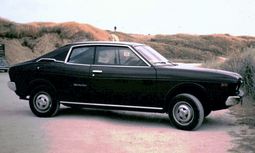

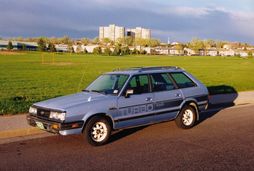
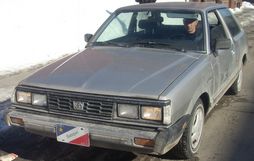

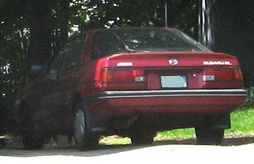

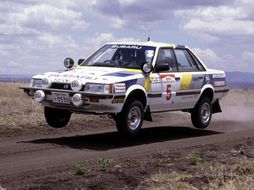
|